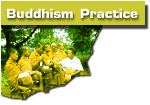 |
BANGKOK
|
||||||||
CENTRAL
|
||||||||||||
NORTHEASTERN
|
||||||||||||||
NORTHERN
|
||||||||||||
SOUTHERN
|
||||
 |
| A GUIDE TO MEDITATION CENTRES IN THAILAND |
| NORTHEASTERN - WAT PAH WANA POTIYAHN |
MEANING
OF NAME : |
"Forest monastery of enlightened wisdom" |
NAME
IN THAI : |
Wat
Keu-an ("Dam monastery") Wat Koh ("Island monastery") |
ADDRESS
: |
Dtumbol Nikom #1, Amper Phibun Mangsahan, Ubon Ratchathani 34110 |
DIRECTIONS
: |
Located on a peninsula on the northeast shore of Sirindhorn Reservoir about 70 km east of Ubon Ratchathani and only 5 km from the Laotian border. (This large reservoir is named after the king's daughter, the Located on a peninsula on the northeast shore of Sirindhorn Reservoir about 70 km east of Ubon Ratchathani and only 5 km from the Laotian border. (This large reservoir is named after the king's daughter, the crown princess.) From Ubon, take a bus east 45 km to Phibun Mangsahan (a "tour" bus from Bangkok also goes here), then take a songtaew east 20 km to Nikom #1; get off at Wana Potiyahn boat landing (ask in advance to be let off here -- you can't see the landing from the road). Ask to be taken across the lake to the monastery (give the boat boys a 20-baht tip), then follow a road 3/4 km to the central area. crown princess.) From Ubon, take a bus east 45 km to Phibun Mangsahan (a "tour" bus from Bangkok also goes here), then take a songtaew east 20 km to Nikom #1; get off at Wana Potiyahn boat landing (ask in advance to be let off here -- you can't see the landing from the road). Ask to be taken across the lake to the monastery (give the boat boys a 20-baht tip), then follow a road 3/4 km to the central area. |
MEDITATION
SYSTEM : |
Similar to Wat Pah Nanachat. |
TEACHING
METHOD : |
Similar to Wat Pah Nanachat. |
TEACHERS
: |
Ajahn Puriso, abbot ( Australian ; age 40) |
LANGUAGE
: |
This is a Thai monastery. The abbot gives Dhamma talks and instruction in Thai. He recommends that visitors know or be willing to learn the language. He will answer questions in English. |
DESCRIPTION
: |
A dense growth of dry tropical forest covers most of themonastery's 2,550-rai (1000-acre) area. The forest is one of the finest of its type in the region. Monks have taken an active role in conservation and protection of the plant and animal life. Denizens of the forest include wild boar, langur (a type of monkey), mouse deer, forest fowl, pheasant, many other birds, and many species of snakes (though rarely seen). Wat Pah Wana Potiyahn is a branch of Ajahn Chah's Wat Nong Pah Pong. A sala, kitchen, scattered kutis, and a boat house are the main buildings. All water has to be hauled from wells. Solar cells power a lighting system for the common areas. |
SIZE
: |
monks
and novices about 10 nuns 0 laypeople a few |
DAILY
ROUTINE : |
Similar to Wat Pah Nanachat. |
FOOD
: |
Good northeastern fare. Supplies may be limited, especially in the hot season. Visitors can also supply their own food and prepare it in the kitchen. The community eats one meal a day. |
ACCOMMODATIONS
: |
Individual kutis for monks, novices, and laypeople. Bathing is done at wells; toilets are Asian-style. |
WRITE
IN ADVANCE? : |
Not necessary. |
OTHER
INFORMATION : |
A good place to practice if you are looking for solitude in a remote forest monastery. Visitors need to have their own practice, be self-reliant, and be willing to learn Thai. Some malaria exists here, so take care to use repellent and netting. Because this is a frontier area near Laos, women should only come and stay in groups of 2 or more. Laypeople observe 8 precepts. Laymen must shave their heads after 3 days. |
| Select here : |
|
|